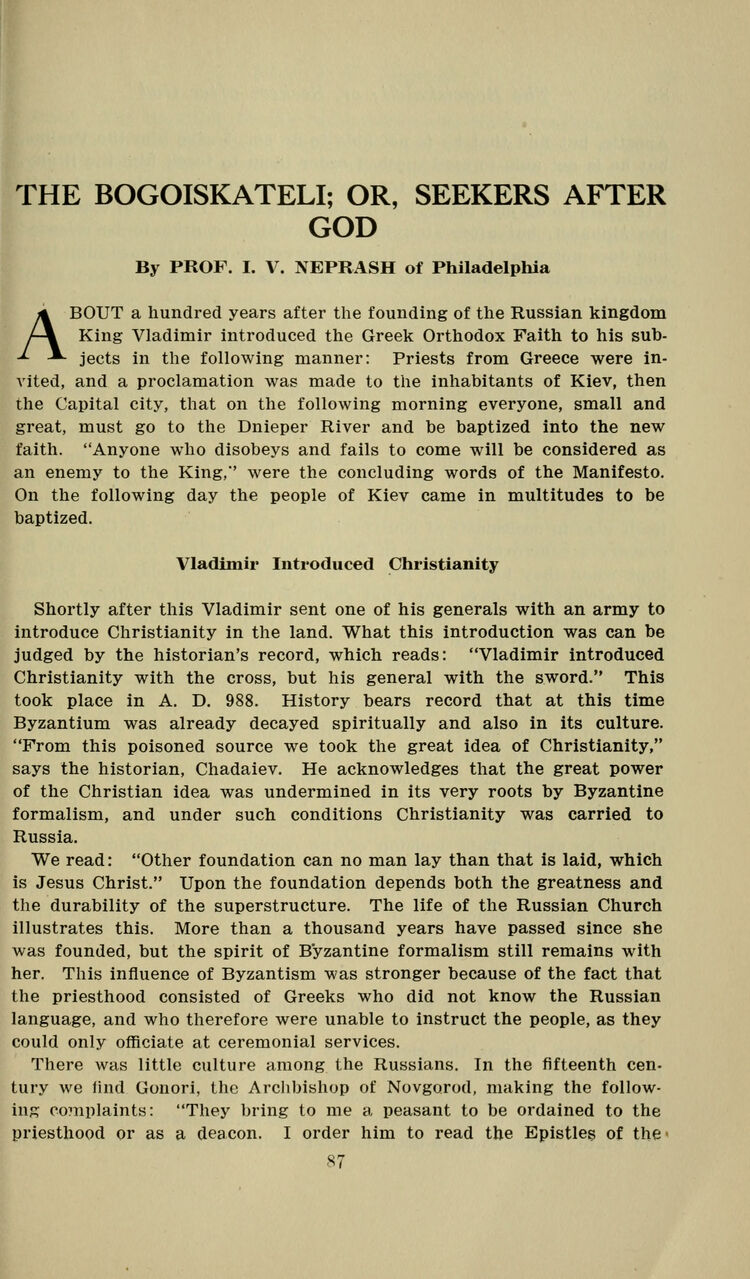
Full resolution (JPEG) - On this page / på denna sida - The Bogoiskateli: or, Seekers After God. Prof. I. V. Noprash - Vladimir Introduced Christianity

<< prev. page << föreg. sida << >> nästa sida >> next page >>
Below is the raw OCR text
from the above scanned image.
Do you see an error? Proofread the page now!
Här nedan syns maskintolkade texten från faksimilbilden ovan.
Ser du något fel? Korrekturläs sidan nu!
This page has never been proofread. / Denna sida har aldrig korrekturlästs.
THE BOGOISKATELI; OR, SEEKERS AFTER
GOD
By PROF. I. V. NEPRASH of Philadelphia
ABOUT a hundred years after the founding of the Russian kingdom
King Vladimir introduced the Greek Orthodox Faith to his sub-
jects in the following manner: Priests from Greece were in-
vited, and a proclamation was made to the inhabitants of Kiev, then
the Capital city, that on the following morning everyone, small and
great, must go to the Dnieper River and be baptized into the new
faith. "Anyone who disobeys and fails to come will be considered as
an enemy to the King," were the concluding words of the Manifesto.
On the following day the people of Kiev came in multitudes to be
baptized.
Vladimir Introduced Christianity
Shortly after this Vladimir sent one of his generals with an army to
introduce Christianity in the land. What this introduction was can be
judged by the historian’s record, which reads: "Vladimir introduced
Christianity with the cross, but his general with the sword." This
took place in A. D. 988. History bears record that at this time
Byzantium was already decayed spiritually and also in its culture.
"From this poisoned source we took the great idea of Christianity,"
says the historian, Chadaiev. He acknowledges that the great power
of the Christian idea was undermined in its very roots by Byzantine
formalism, and under such conditions Christianity was carried to
Russia.
We read: "Other foundation can no man lay than that is laid, which
is Jesus Christ." Upon the foundation depends both the greatness and
the durability of the superstructure. The life of the Russian Church
illustrates this. More than a thousand years have passed since she
was founded, but the spirit of Byzantine formalism still remains with
her. This influence of Byzantism was stronger because of the fact that
the priesthood consisted of Greeks who did not know the Russian
language, and who therefore were unable to instruct the people, as they
could only officiate at ceremonial services.
There was little culture among the Russians. In the fifteenth cen-
tury we find Gonori, the Arclibishop of Novgorod, making the follow-
ing co7nplaints: "They bring to me a peasant to be ordained to the
priesthood or as a deacon. I order him to read the Epistles of the’
87
<< prev. page << föreg. sida << >> nästa sida >> next page >>